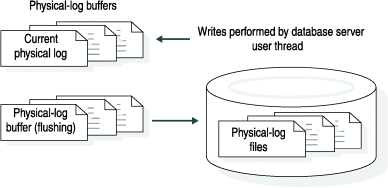
The database server temporarily stores before-images of some of the modified disk pages in the physical-log buffer. If the before-image has been written to the physical-log buffer but not to the physical log on disk, the physical-log buffer must be flushed to disk before the modified page can be flushed to disk. This action is required for the fast-recovery feature. Writing the before-image to the physical log buffer and then flushing the buffer page to disk is illustrated in Figure 42.

Both the physical-log buffer and the physical log contribute toward maintaining the physical and logical consistency of the data. For a description of physical logging, refer to Physical Logging. For a description of checkpoints and fast recovery, refer to Checkpoints and Fast Recovery.
The following four events cause the current physical-log buffer to flush:
The contents of the physical-log buffer must always be flushed to disk before any data buffers. This rule is required for the fast-recovery feature.
The database server uses only one of the two physical-log buffers at a time. This buffer is the current physical-log buffer. Before the database server flushes the current physical-log buffer to disk, it makes the other buffer the current buffer so that it can continue writing while the first buffer is being flushed.
Buffer flushing that results from the physical-log buffer becoming full proceeds as follows.
When a user thread needs to write a before-image to the physical-log buffer, it acquires the mutex associated with the physical-log buffer and the mutex associated with the physical log on disk. If another thread is writing to the buffer, the incoming thread must wait for the mutexes to be released.
After the incoming thread acquires the mutexes, but before the write, the thread checks to see what percent of the physical log is full.
If the physical log is more than 75 percent full, the thread sets a flag to request a fuzzy checkpoint. Next, the thread claims the amount of space in the buffer that it needs for its write and releases the buffer mutex so that other threads can access the buffer. Finally, it copies the data to the space that it claimed in the buffer. The checkpoint does not begin until all user threads, including this one, are out of critical sections. For more information on critical sections and checkpoints, refer to How the Database Server Achieves Data Consistency.
If the physical log is less than 75 percent full, the thread compares the page counter in the physical-log buffer header to the buffer capacity. If this one-page write does not fill the physical-log buffer, the thread reserves space in the log buffer for the write and releases the mutex. Any thread waiting to write to the buffer is awakened. After the thread releases the mutex, it writes the page to the reserved space in the physical-log buffer. The sequence of this operation increases concurrency and eliminates the need to hold the mutex during the write.
If this one-page write fills the physical-log buffer, flushing is initiated. First the page is written to the current physical-log buffer, filling it. Next, the thread latches the other physical-log buffer. The thread switches the shared-memory current-buffer pointer, making the newly latched buffer the current buffer. The mutex on the physical log on disk and the mutex on this new, current buffer are released, which permits other user threads to begin writing to the new current buffer. Last, the full buffer is flushed to disk, and the mutex on the buffer is released.
Home | [ Top of Page | Previous Page | Next Page | Contents | Index ]